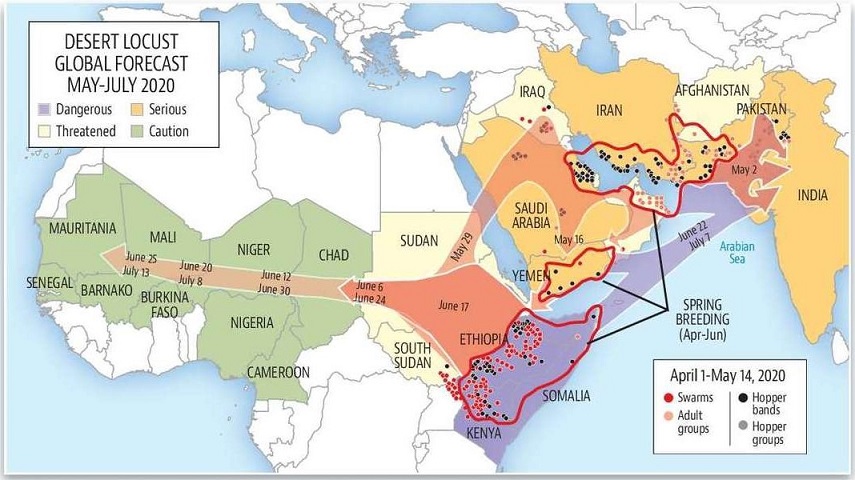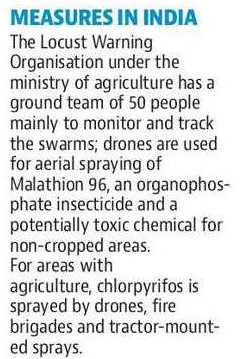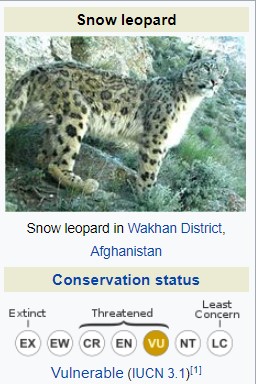Contents
- ILO to PM: ‘Send clear message’ on labour law changes
- China warns U.S. if punished for Hong Kong law
- China looks to evacuate its citizens from in India
- Locust Invasion
- Snow leopard conflict cases rise in Ladakh
ILO TO PM: ‘SEND CLEAR MESSAGE’ ON LABOUR LAW CHANGES
Focus: GS-III Indian Economy
Why in news?
The International Labour Organisation (ILO) has urged Prime Minister to “send a clear message” to the Central and State governments to uphold international labour laws after the recent dilution of laws by some States.
Why is ILO showing concern?
- A group of 10 Central trade unions wrote to the ILO in Geneva on May 14, seeking its intervention to protect workers’ rights and international labour standards.
- They sent the representation to the ILO after Uttar Pradesh, Madhya Pradesh, Gujarat and some other States either suspended a large number of labour laws for two-three years or diluted them in an attempt to woo industry in the midst of the COVID-19 pandemic.

International Labour Organization (ILO)
- The International Labour Organization (ILO) is a United Nations agency whose mandate is to advance social justice and promote decent work by setting international labour standards.
- It was the first specialised agency of the UN.
- The ILO has 187 member states: 186 of the 193 UN member states plus the Cook Islands are members of the ILO.
- In 1969, the ILO received the Nobel Peace Prize for improving fraternity and peace among nations, pursuing decent work and justice for workers, and providing technical assistance to other developing nations.
ILO’s Tripartite Structure:
- Unlike other United Nations specialized agencies, the International Labour Organization has a tripartite governing structure that brings together governments, employers, and workers of 187 member States, to set labour standards, develop policies and devise programmes promoting decent work for all women and men.
- The tripartite structure is unique to the ILO where representatives from the government, employers and employees openly debate and create labour standards.
- The structure is intended to ensure the views of all three groups are reflected in ILO labour standards, policies, and programmes, though governments have twice as many representatives as the other two groups.
The Functions of the ILO
- Creation of coordinated policies and programs, directed at solving social and labour issues.
- Adoption of international labour standards in the form of conventions and recommendations and control over their implementation.
- Assistance to member-states in solving social and labour problems.
- Human rights protection (the right to work, freedom of association, collective negotiations, protection against forced labour, protection against discrimination, etc.).
- Research and publication of works on social and labour issues.
Objectives of the ILO
- To promote and realize standards and fundamental principles and rights at work.
- To create greater opportunities for women and men to secure decent employment.
- To enhance the coverage and effectiveness of social protection for all.
- To strengthen tripartism and social dialogue.
Click Here to read more about Labour Law Reforms for UPSC
-Source: The Hindu
CHINA WARNS U.S. IF PUNISHED FOR HONG KONG LAW
Focus: GS-II International Relations
Why in news?
China on 25th May 2020 threatened counter-measures against the U.S. if it was punished for plans to impose a sedition law on Hong Kong.
Background: What prompted the Warning?
- Beijing plans to pass a new security law for Hong Kong that bans treason, subversion and sedition after months of massive, often-violent pro-democracy protests last year.
- But many Hong Kongers, business groups and Western nations fear the proposal could be a death blow to the city’s treasured freedoms.
- As police dispersed the crowds with tear gas and water cannon, Washington’s National Security Advisor warned the new law could cost the city its preferential U.S. trading status.
What each of the Players say?
China
Beijing portrays the city’s protests as a foreign-backed plot to destabilise the motherland and says other nations have no right to interfere in how the international business hub is run.
Protesters in Hong Kong
Protesters say they are motivated by years of Beijing chipping away at the city’s freedoms since it was handed back to China by Britain in 1997.
Their particular concern is a provision allowing Chinese security agents to operate in Hong Kong, with fears it could spark a crackdown on those voicing dissent against China’s communist rulers.
Hong Kong Government
Hong Kong’s government has welcomed the law.
U.S.
The U.S. Department of Commerce announced sanctions triggered by human rights abuses against Uighurs and other minority groups in Xinjiang in China’s far northwest. The U.S. is also warning that the new Hong Kong law will affect the preferential U.S. trading status towards China.
Click Here to read more about the New Hong Kong Law
How would protests affect India – Hong Kong trade?
- During the large-scale protests in Hong Kong during the final months of 2019 before the COVID-19 Lockdown – Hong Kong Trade Development Council (HKTDC) said that the protests would not impact its bilateral trade with India, which stood at around USD 31 billion in 2018-19.
- There was a small decline in exports from India to Hong Kong in the first four months of the fiscal year, but that had more to do with global trade sentiments and India’s economic scenario rather than the protests.
-Source: The Hindu
CHINA LOOKS TO EVACUATE ITS CITIZENS FROM IN INDIA
Focus: GS-II International Relations
Why in news?
China on 25th May 2020 announced plans to evacuate its citizens facing “difficulties” in India because of the coronavirus pandemic, risking speculation in the middle of heightened military tensions between the two nations.
Details
- A notice put up on the Chinese embassy website advised those who wanted to go home, including students, tourists, and businesspeople, to book tickets on special flights.
- The move to evacuate Chinese citizens from India comes against the backdrop of India entering the list of the 10 worst-hit nations by the novel coronavirus, with more than 150,000 infections and 4,100 deaths.
- The evacuation also comes at a time of high military tensions between India and China, with Chinese troops transgressing into Indian territory in several places in Ladakh and Sikkim in May 2020.
Related Articles
Changed dynamic along India-China border
Military, diplomatic talks on with China
-Source: Livemint
LOCUST INVASION
Focus: GS-III Environment and Ecology
Why in news?
- Swarms of crop-munching desert locusts entered deeper into Rajasthan, Madhya Pradesh and Uttar Pradesh over the weekend and are now close to the national capital.
- Officials have put farmers on high alert and deployed insecticide spraying devices through drones, SUVs and tractors, on 25th May.
Why is it serious this time?

- Locust invasions are common in parts of Rajasthan abutting Pakistan.
- However, this is the first time they have reached Jaipur – after charting a journey that experts believe began in their natural breeding ground in East Africa.
- The Jaipur swarm was only one of three swarms that was spreading. The second lot seems to be heading for Morena in Madhya Pradesh. The third in Jaipur region seem to be heading towards Gangapur city in Rajasthan.
- Most of the swarm seen at present consists of pink-hued sub-adult locusts. Officials fear these may arc back to their summer breeding area in the desert between India and Pakistan, where monsoon rains can help trigger a new round of breeding.
- If the wind and the conditions are suitable the locusts will move towards Delhi making the situation worse, according to Locust Warning Organization (LWO).
- The LWO is coordinating with the India Meteorological Department to determine the trajectory the insects might take.
- The locust outbreak this time is linked to climate change and unusual rain.
- The current breed of locusts unsettles on hearing sound of tractors, making the spraying of pesticides more difficult.
Desert Locusts

- The desert locust (Schistocerca gregaria) is a short-horned grasshopper that is innocuous while it is in a “solitary phase” and moving about independently.
- The life of a locust varies between three and five months. These insects do not pose a direct risk to animals or humans.
- These winged insects differ from normal hoppers, and become dangerous only when their populations build up rapidly and the close physical contact in crowded conditions triggers behavioural changes.
Why are they a serious problem, how do they spread?

- Locusts are polyphagous, i.e. they can feed on a wide variety of crops.
- Secondly, they have an ability to multiply rapidly. A single female desert locust lays 60-80 eggs thrice during its roughly 90-day life cycle.
- The damage potential of locusts has been limited in India only because of the country hosting a single breeding season — unlike Pakistan, Iran and East Africa, where they also multiply during January-June.
- When they are in close contact with each other in crowded situation, they enter the “gregarious phase”, by grouping into bands and forming swarms that can travel great distances (up to 150 km daily), while eating up every bit of vegetation on the way.
- If not controlled at the right time, these insect swarms can threaten the food security of countries.
- Locusts can fly up to 150 kilometres in a day and a one-square-kilometre swarm can eat as much food as 35,000 people, in terms of weight, in a single day.

-Source: Hindustan Times
SNOW LEOPARD CONFLICT CASES RISE IN LADAKH
Focus: GS-III Environment and Ecology
Why in news?
There have been around nine snow leopard conflict cases reported in Ladakh during the April and May months of national lockdown where the Snow Leopards have killed or attacked livestock in village corrals, according to the wildlife protection department of Jammu and Kashmir.
Snow Leopards getting closer
- Snow leopards and Himalayan brown bears have been seen to be moving about more freely closer to habitation compared to 2018 and 2019.
- The recent conflicts may be linked to less movement of humans during lockdown.
- Snow Leopards do not find enough prey in high altitudes and so tend to come down, especially during February to March (the mating season) and then the birthing season in May to July as they are tired and look for food during this time.
- The environment ministry has asked Wildlife Institute of India to study the impact of lockdown on wildlife.
Snow leopard

- The snow leopard is a large cat native to the mountain ranges of Central and South Asia.
- It is listed as Vulnerable on the IUCN Red List.
- The snow leopard, like all big cats, is listed on Appendix I of the Convention on International Trade of Endangered Species (CITES), which makes trading of animal body parts (i.e., fur, bones and meat) illegal in CITES signatory countries.
- Global population is estimated to number less than 10,000 mature Snow Leopards.
- It inhabits alpine and subalpine zones at elevations from 3,000 to 4,500 m.
- It is threatened by poaching and habitat destruction following infrastructural developments.
Snow Leopards in India
- In India, their geographical range encompasses a large part of the western Himalayas including the states of Jammu and Kashmir, Himachal Pradesh, Uttarakhand and Sikkim and Arunachal Pradesh in the eastern Himalayas.
- The last three states form part of the Eastern Himalayas – a priority global region of WWF and the Living Himalayas Network Initiative.
- Project Snow Leopard (PSL): It promotes an inclusive and participatory approach to conservation that fully involves local communities.
- SECURE Himalaya: Global Environment Facility (GEF)-United Nations Development Programme (UNDP) funded the project on conservation of high-altitude biodiversity and reducing the dependency of local communities on the natural ecosystem. This project is now operational in four snow leopard range states, namely, Jammu and Kashmir, Himachal Pradesh, Uttarakhand, and Sikkim.
-Source: Hindustan Times





